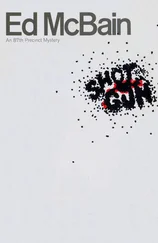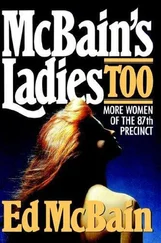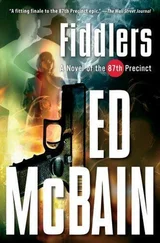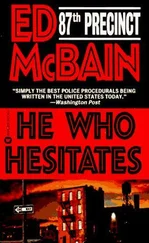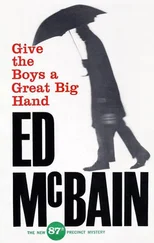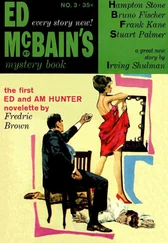The sewer opening was little more than a narrow metal rectangle set into the cement curb. There were no sidewalks on the street; lawns of grass or pebbles stretched immediately to the roadway, where they sloped into asphalt. But the sewer had been built into a concrete mini-sidewalk some four feet square, and a cast-iron manhole cover afforded easy access to the drain below. Di Luca went back to the car for a crowbar, and then pried off the cover. In the house across the street, a woman watched from inside her screened lanai. Ehrenberg rolled the cover onto a patch of parched grass. The sewer was relatively shallow, some three or four feet deep. An inch or so of water lay stagnant on the bottom; it had not rained in Calusa all month long. Resting in the water on a bed of sand and silt was a knife with a ten-inch blade.
“Is that the knife you used to kill them?” Bensell asked.
“That’s the knife,” she said.
It was a little past one when we got back to the police station.
Michael was still in his cell on the second floor; I could only assume he had not yet been moved across the street because of the new developments in the case. I followed the jailer down the long corridor, watched him insert the color-coded key into the keyway. He swung the steel door back, and did not lock it behind him. We walked past the row of cells to the bend in the corridor, and then to Michael’s cell. The jailer opened the barred door for me, and then locked me in. Michael was sitting on the grimy foam-rubber mattress. I heard the metal door clanging shut around the bend in the corridor, heard the key being twisted again.
I told Michael that his sister had confessed to the murders. I told him that she had led them to where she’d thrown the murder weapon down a sewer, and that Ehrenberg was fairly certain they would be able to recover latent prints and blood samples from the knife. There were cracks and crevices in the handle, and blood would have caked in it someplace. The water in the sewer was still, there was no possibility it could have completely washed away the blood; nor would water have had any effect on fingerprints.
I told him that the State’s Attorney was dubious about fingerprints and blood proving Michael’s sister had committed the murders. The way he saw it, this only proved she had transported the murder weapon to the sewer and disposed of it. I told Michael that Ehrenberg was hoping the latent prints they’d gathered all around the house would match up with his sister’s — prints on the phone, the doorknob, the faucet handles in the bathroom, where she said she’d washed the blood from her hands. But Bensell had debated the value of the prints as evidence, saying they would only prove she’d been in the house and not that she’d murdered Maureen and the children.
I told Michael that the police had confirmed his sister’s telephone call to the marina, that the dockmaster there had told them he’d taken the call at eleven-thirty and had gone to the boat to get Michael. But Bensell said this only meant she’d called Michael, and not that she’d called him from the house during the time the coroner’s report had stated the murders occurred — between ten and midnight. Bensell maintained that Karin could have called her brother from anywhere in Calusa, asking him to meet her at the house, where together they could have committed the murders. I explained that they were at this moment booking his sister for Murder One, but that they would not release him till they were convinced he’d had nothing to do with the commission of the crime.
“Michael,” I said, “I’d like you to take a polygraph test.”
“What for?”
“Because there’s no way you can help your sister now. The only person you can help is yourself.”
“You just told me the fingerprints wouldn’t prove—”
“Michael, they’ll let you go the minute they’re sure you had nothing to do with this.”
“I had everything to do with it. I killed them.”
“Jesus, you’re a pain in the ass!”
“Why couldn’t she have stayed out of this?” he said.
“I guess for the same reason you couldn’t,” I said.
He looked at me. He nodded. He sighed heavily.
It was Ehrenberg’s opinion, and mine as well, that Michael had blended what he knew had happened with what he imagined had happened, using his intimate knowledge of the house — and what he had found there on his arrival — to construct a scenario within a plausible setting. There had always been a problem about his motive, but if we were to accept the existence of the knife rack, for example, then why not accept his statement that he’d seized a knife from that rack? If we were to believe that he’d kissed his dead stepmother on the mouth — and we both did believe it — then why not also believe he had stabbed her first? There had been no way of sorting the lies from the truth; in Michael’s various tellings, all had sounded equally genuine; even the hesitations, the groping for words seemed not really a lapse in inventiveness but only the customary disorientation of a person confessing to a brutal crime.
The polygraph would accept no lies.
A trained examiner would ask Michael questions, and the machine would accurately record any changes in his blood pressure, respiration, pulse, and electrodermal response. Ehrenberg was hopeful that the boy would be released before sundown, provided the test results showed what he thought they would. Bensell seemed a bit more dubious, and insisted he would not let Michael out on the street till he was absolutely certain of his innocence. They both advised me to go home. The test would take some time, and there was no sense in my hanging around. Ehrenberg promised he would call me as soon as he had the results.
I left the Public Safety Building at two-thirty that afternoon.
I didn’t know where to go.
I got into the Ghia, and started driving toward the office, and then turned in the opposite direction and headed for the bay. I wanted to go home, I guess, but I didn’t know where home was.
Aggie once asked me — this was last October, our love was still new then — whether we wouldn’t grow tired of each other soon enough, seek new partners again, look again for the danger or the thrill or the romance or whatever it had been that caused us to discover each other in the first place. She had been sitting on the edge of the bed naked, looking out toward the marsh on the eastern side of the house; the sun had already moved over to the beach side, this was two or thereabouts in the afternoon. She said she thought the reason people enjoyed stories about love affairs was not because they secretly longed for such affairs themselves. On the contrary, most of the stories ended in affirmation of the marital bond — the sinners going back to their respective spouses at the end. She went on to speculate that the happy ending was essential to any story of marital infidelity, and then she said—
She said that maybe those two strangers meeting on a train weren’t strangers at all. Maybe the woman was only Mrs. Smith as a young girl, and the man was Mr. Smith as he’d been when she first met him. The entire so-called “affair” was just a tale of their courtship and romance, a memory of more passionate times, with the “going back” at the end, the “happy ending” being a symbolic return to the humdrum safer reality of marriage. She was pleased with her idea. She waited for my approval, grinning, and then she kissed me. And then we made love again and in a little while I left her.
I drove over the causeway bridge now, and around Lucy’s Circle, and then across the new bridge to Sabal. But instead of continuing on toward Stone Crab Key, I made an abrupt left turn onto Jamie’s street and found myself driving slowly past the scene of the crime. The jacaranda stood leafless and flowerless in the center of the lawn. A month from now, it would explode against the sky in a glorious puff of feathery purple flowers, but now there were only naked branches and not a hint of promised bloom. I drove up the street toward West Lane, past the sewer into which the murder weapon had been dropped.
Читать дальше

